Alphard, designated as Alpha Hydrae, is the brightest star in the constellation of Hydra. Alphard is a giant star, cooler than our Sun yet larger and more luminous.
Key Facts & Summary
- Alphard is located at around 177 light-years / 54 parsecs away from the Sun.
- Alphard has evolved away from the main sequence and became a giant star with a spectral classification of K3 II-III – it’s luminosity class being in between II and III, appearing orange in color.
- The angular diameter of Alphard is only beaten by stars such as Betelgeuse or R Doradus.
- Alphard has 3.03 solar masses, yet in regards to its radius, Alphard has 50.5 solar radii.
- Alphard is 780 times brighter than our Sun.
- The surface gravity of Alphard has been measured at around 1.54 cgs.
- Alphard completes one rotation on its axis once every 2,991 days, having a slow rotational velocity of 1.1 kilometers / 0.6 miles per second.
- The surface average temperatures on Alphard have been recorded at around 4,120 K.
- Alphard has a radial velocity of about -4.3 km / 2.6 mi per second.
- The apparent magnitude of Alphard is +2.00, while its absolute magnitude is -1.69.
- The estimated age of Alphard is 420 million years. It is quite young in comparison to our Sun.
- Alphard’s spectrum shows a mild excess of barium, an element that is normally produced by the s-process of nucleosynthesis.
- Typically, a barium star belongs to a binary system and the anomalies in abundances are explained by mass transfer from a companion white dwarf.
- Alphard is not only the brightest star in the Hydra constellation, but it also marks the celestial Water Snake’s heart.
The name of the star, Alphard, is derived from the Arabic “al-fard” – meaning “the solitary one”. It was named as such since Alphard’s position in the sky doesn’t contain other exceptionally bright stars.
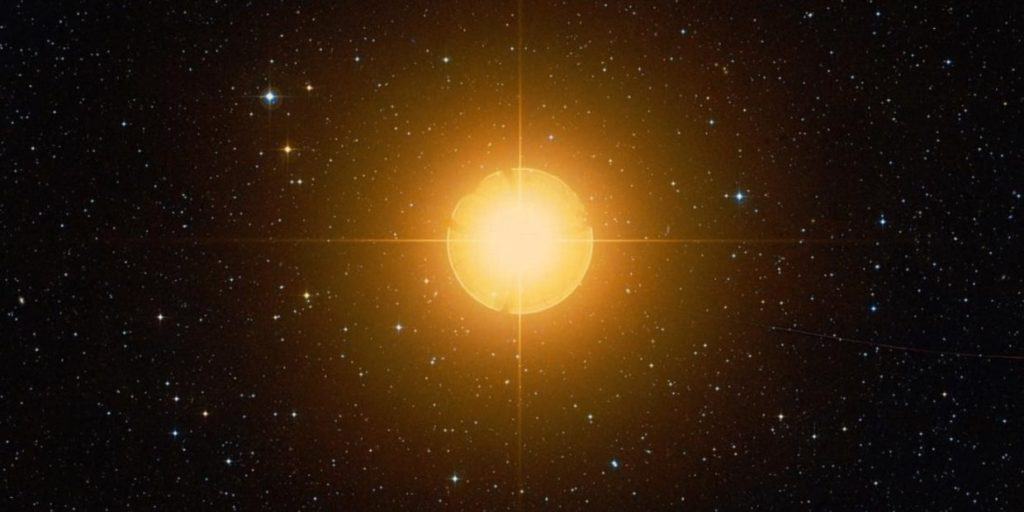
This named was approved by the IAU in 2016. In Arabic astronomy, Alphard was called the “backbone of the Serpent”, while the Danish astronomer Tycho Brahe called the star “Cor Hydrae” – the Latin for “the heart of the Hydra” – since it marks the celestial snake’s heart.
Formation
Alphard formed around 420 million years ago from an interstellar medium of dust and gas. Gravity pulled the swirling gas and dust together and when the right temperature was reached, the brightest star in Hydra, Alphard, was born.
Distance, Size, and Mass
Alphard is situated at around 177 light-years / 54 parsecs away from the Sun. It is so bright that it can be seen with the naked eye.
Since Alphard has evolved away from the main-sequence and became a giant star, its radius has expanded considerably. Alphard’s radius has been estimated at around 50.5 solar radii or 5050% times the Sun’s radius.
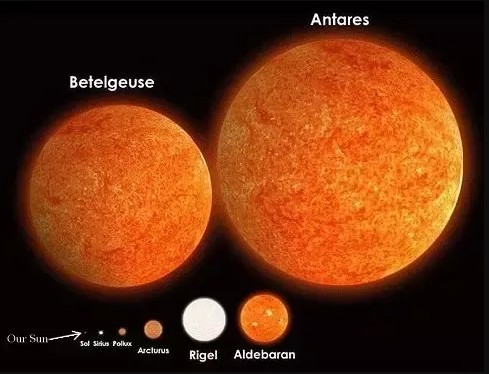
The angular diameter of Alphard is also impressive, being beaten only by stars such as Betelgeuse or R Doradus. In regards to its mass, Alphard has around 3.03 solar masses or 303% of the Sun’s mass.
Other Characteristics
Alphard / Alpha Hydrae, is an orange star of spectral type K3 II-III, indicating a giant (III) or bright giant (II) star. Alphard is around 780 times brighter than our Sun, yet it is much cooler having surface average temperatures of around 4,120 K, or only 70% of the Sun’s heat.
The star is also a slow spinner, having a rotational velocity of 1.1 km / 0.6 mi per second, completing one rotation every 2,991 days. Alphard is also a mild barium star.
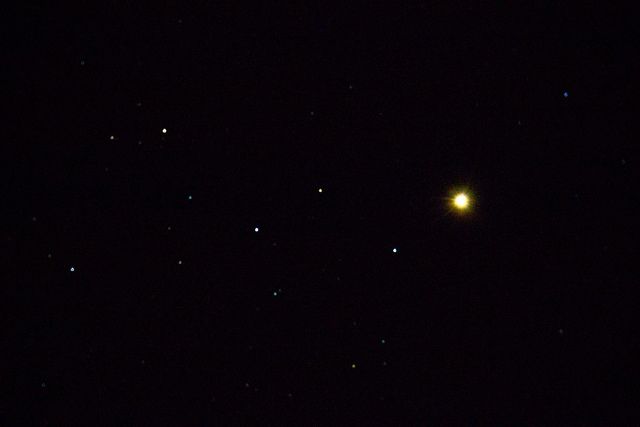
Its spectrum displays an excess of barium which typically indicates a mass transfer from a white dwarf companion. White dwarfs are dense remnants of stars that have expelled their outer layers and in a binary system, some of the expelled gas would often fall onto the companion star and pollute its surface layers.
However, astronomers haven’t been able to find this white dwarf companion, and thus it is believed that it has faded and it can no longer be seen.
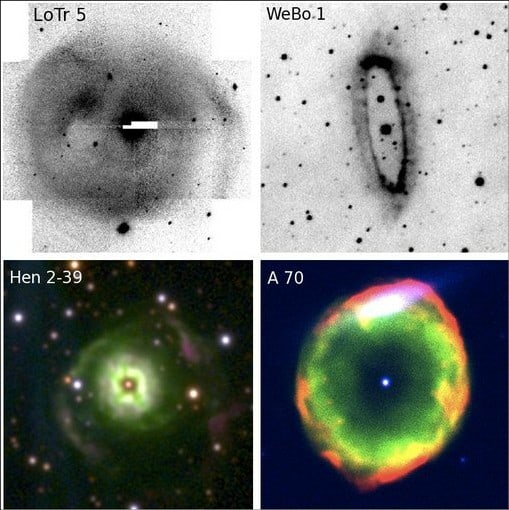
Alphard has oscillations periods ranging from several hours to a few days which are believed to be a result of stellar pulsations. This makes Alphard a great target for asteroseismology studies.
Location
Alphard is located in the constellation of Hydra, the celestial Water Snake, being the brightest star there. The constellation of Hydra is the largest of all the 88 modern constellations, occupying 1,303 square degrees of the southern sky.
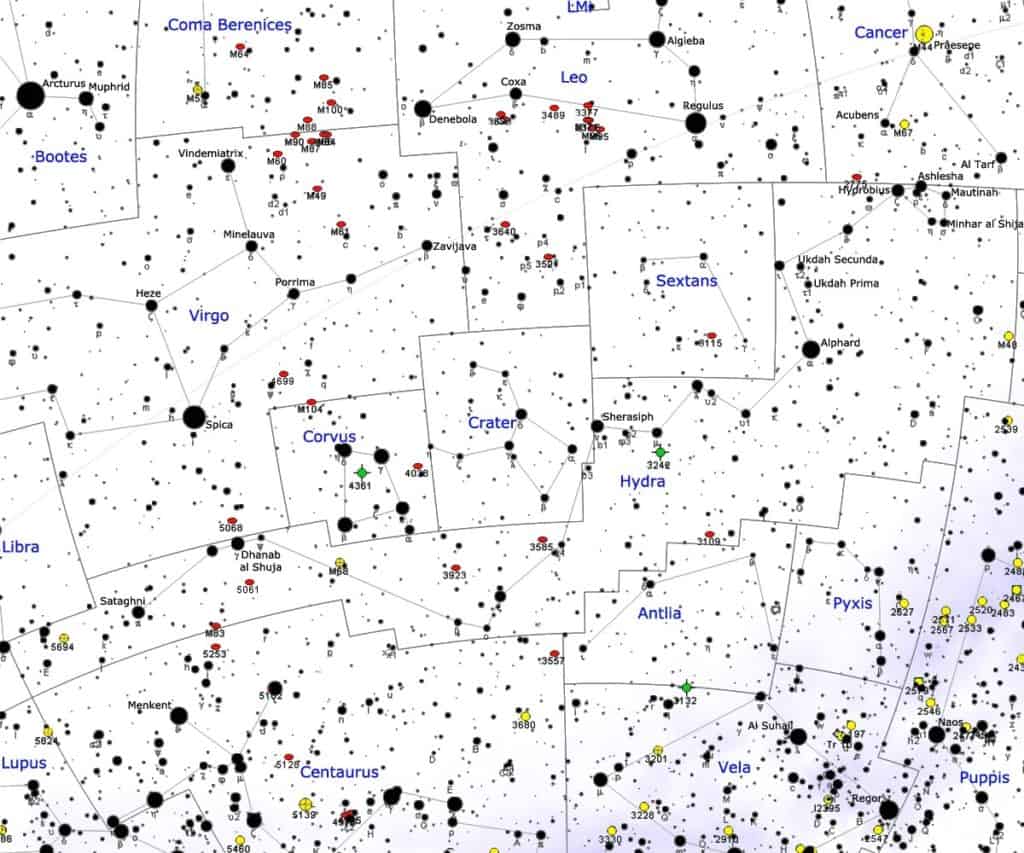
The constellation represents the multi-headed monster killed by Heracles in Greek mythology. Hydra is among the 48 Greek constellations, first listed by Ptolemy in the 2nd century CE.
Though it is the largest constellation, Hydra is not particularly prominent, with only two stars, Alphard and the yellow giant Gamma Hydrae being brighter than magnitude 3.
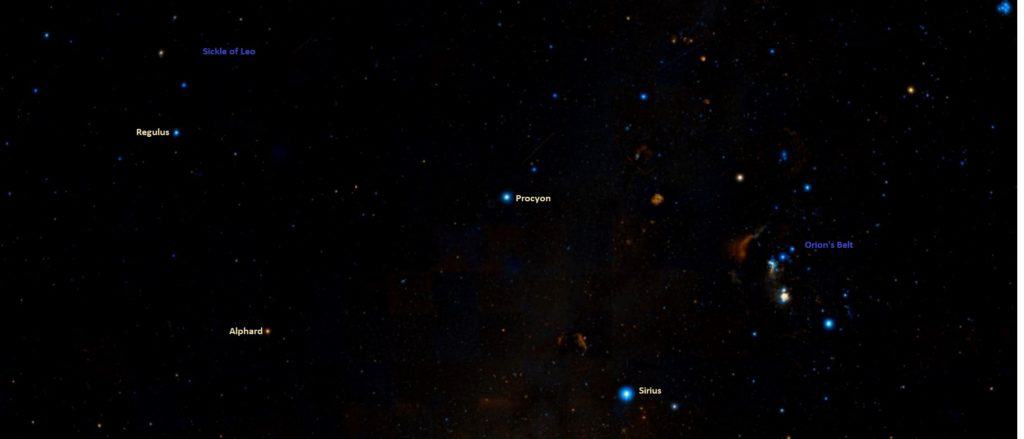
Alphard is located in an area of the sky that doesn’t contain many bright stars or asterisms that would make the star easily identifiable. Observers in the north would find Alphard southwest of Regulus in Leo, appearing to the lower left of Sirius, the brightest star in the sky. Alphard forms a triangle with Regulus and Procyon.
The star can be used to find the spiral galaxies NGC 2855 and PGC 25886, which lie in the vicinity of the star. The constellation of Hydra, though devoid of bright stars, contains several interesting deep sky objects.
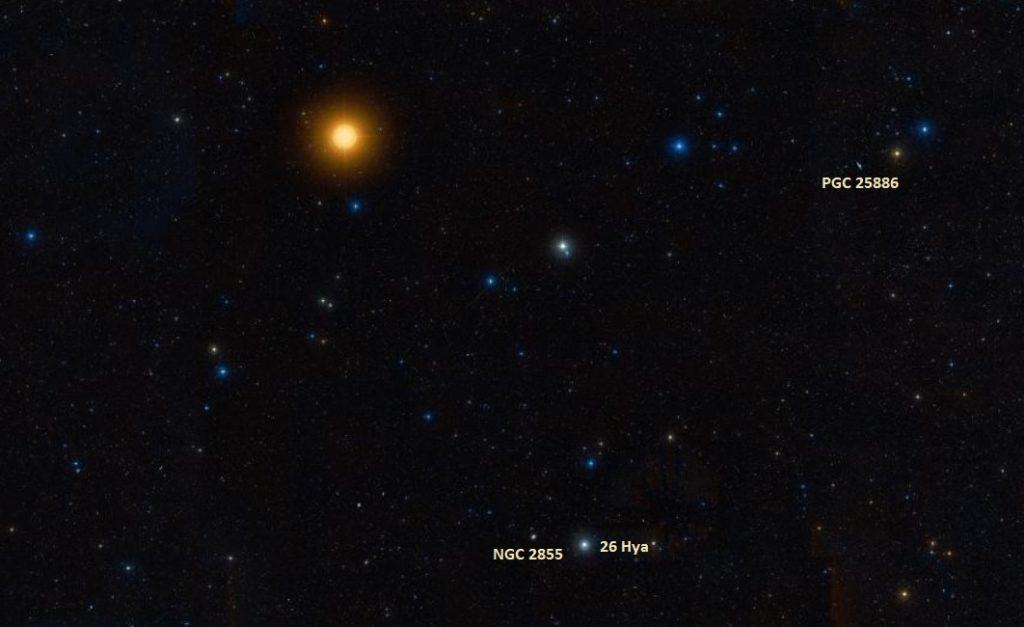
These include three Messier objects – the Southern Pinwheel Galaxy (Messier 83), the globular cluster Messier 68, and the open cluster Messier 48.
Other deep-sky objects include the globular cluster NGC 5694, the superimposed pair of galaxies cataloged as NGC 3314, the lenticular galaxy NGC 4993, the irregular galaxy NGC 2936, the Hydra Cluster of galaxies, and the planetary nebulae Abell 33 and NGC 3242, also known as the Ghost of Jupiter.
The best time of the year to observe the stars and deep-sky objects in Hydra is during the month of April.
The Future
Similar to its elusive white dwarf companion, Alphard’s fate is to become a white dwarf as well. Alphard is not massive enough to explode as a supernova.
When the star will reach the end of its life, it will cast off its outer layers to form a planetary nebula and gradually fade as a white dwarf. However, this won’t happen very soon and thus we can still observe and admire the brightest-star in Hydra for a long time to come.
Did you know?
- Alphard is among the 58 stars bright stars used for navigation. It is the only navigational star in Hydra.
- Alphard is one of the stars featured on the flag of Brazil. Every star represents a Brazilian Federative Unit and Alphard symbolizes the state of Mato Grosso do Sul.
- In ancient China, Alphard was part of an asterism known as the “red bird”.
- In the more modern China, Alphard is known as the First Star of Star A Chinese asterism formed by Tau1 Hydrae, Tau2 Hydrae, Ukdah, 27 Hydrae, 26 Hydrae, HD 82428, and HD 82477. The Star mansion is one of the seven mansions of the Vermilion Bird.
- The Toyota Alphard, a minivan made by Toyota, was named after the star.
Sources:
Image sources:
- https://www.star-facts.com/wp-content/uploads/2020/03/Alphard-1240×620.jpg?189db0&189db0
- https://i.pinimg.com/originals/c7/2a/32/c72a32a8677d9745041a3f063960b3e4.jpg
- https://i.pinimg.com/originals/aa/5d/3a/aa5d3a040e98c5ce117f70b5fa4ce071.jpg
- https://www.salt.ac.za/wp-content/uploads/sites/75/2015/05/barium41.jpg
- https://www.star-facts.com/wp-content/uploads/2020/03/Hydra-constellation.jpg?189db0&189db0
- https://www.star-facts.com/wp-content/uploads/2020/03/Alphard-location.jpg?189db0&189db0
- https://www.star-facts.com/wp-content/uploads/2020/03/Alphard-NGC-2855-and-PGC-25886.jpg?189db0&189db0
